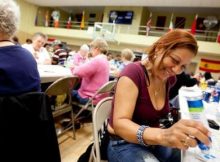How Is Math Used In Bingo?
How is math used in bingo? Most of the time, it’s used behind the scenes, so you don’t have to think about it when you’re playing. Here are some of the ways companies use math for 90 Ball Bingo.

Picking Numbers
The most obvious aspect of math in bingo is the method of selecting numbers. Some places have digital number selection systems, while others use machines with balls or draw tokens from a box. There are countless ways to pick numbers, and it doesn’t matter much which method people use as long as it’s fair.
Bingo relies heavily on fairness for its games, so some companies go to great lengths to ensure the results are as genuinely random as possible. That usually means the caller cannot figure out what a number will be before they select it and, therefore, cannot influence the game.
When bingo uses physical setups, like balls, numbers are usually printed onto them to ensure every ball feels the same. Number-picking software is, likewise, fully randomised.
Creating Cards
The other obvious manifestation of math in bingo appears on the cards. Maths tells us that there are more than 24 quadrillion unique combinations on a 90-ball bingo card, so the odds of two players having the same card in any bingo game are near-nonexistent.
While it could happen in theory, the chance this occurs with randomly-generated cards is so low that it will probably not happen in the entirety of human history. There could be problems if people are allowed to create their own cards and decide to make identical cards on purpose, but reputable bingo establishments don’t permit this.
However, while cards are different, that doesn’t mean ties can’t happen anyway. Companies put a lot of effort into trying to ensure that all the cards in a game have different win rates, but you’re practically guaranteed some cards if there’s a certain number of players.
The number of cards that can tie in a game has no direct correlation with the chances of winning. Every ticket has a statistically equal chance of winning, so this is math that applies more outside of the game than in it.
Setting Jackpots
So, when money is on the line, how is math used in bingo? Carefully.
That is the part that’s not obvious to most players. Bingo uses three primary types of jackpots for players, two of which are more common than the others. Maths affects these in different ways, but the real focus is ensuring enough profit for the hosts.
Reputable online bingo sites (like those on our list) and quality in-person locations will generally say what per cent of each ticket sale is returned to customers. Most keep 15% to 25% of the ticket sales, and the rest goes towards player prizes. Anything outside this range is a little suspicious and may justify closer examination before you play with them.
Grouping Games Online
If you’re playing bigo online, you might not be playing exclusively with people from the same site. Many online games go through a bingo network, which is essentially a server system for the games. Bingo sites can use these to run their games for a small operating fee, and since they’re using the same rules, they can offer better payouts.
Fixed Jackpots
Fixed jackpots have a predetermined value regardless of the number of players or the ticket prices involved. These are the most steady and reliable games, so they’re usually easy to find.
However, since fixed jackpots don’t have changing prizes, there’s no possibility of a big win. That represents the low-risk, low-reward scenario typical in bingo, which makes it the most popular choice among casual players.
Fixed jackpots tend to have fewer players when other pots are growing, so they also have higher odds of winning. You have a much better chance of winning a prize if you’re playing against 20 people instead of 1000.
Progressive Jackpots
Progressive jackpots increase their reward by using a percentage of ticket sales. That comes from the provider’s end and is separate from the standard amount that goes back to players. A common setup involves contributing around 2% of every ticket sale to the jackpot, then another 75% or so as the fixed reward for the game.
Numbers can vary between providers, but the most common setup is having people earn a much higher percentage of the jackpot for winning a game in a low number of calls.
While you can theoretically get a full house in just fifteen calls, the odds of this are vanishingly insignificant. Most progressive jackpots start around 31 or 32 calls for their greatest reward, where the odds of getting “House” are about one in 100 million.
The reward scales down to around 45 calls, where the prize per cent is the lowest, and the odds are better. At 45 calls, the chance of someone having a full house is about one in seven-point-five million, but the odds of winning will go up quite quickly from there. Most games end in the 60 to 70 calls range.
The most important part of maths in a progressive jackpot is ensuring the ticket sales for new games outweigh what players can claim from the pot in a typical game. If they’re too low, the pot depletes, discouraging participation.
Escalator Jackpots
Escalator jackpots are the rarer option, although you may occasionally see them on sites like MrQ Bingo and The Sun Bingo.
In an escalator format, part of the ticket price goes to a jackpot, but it doesn’t pay out until someone meets the criteria for getting the whole thing. It depends on a predetermined number of calls that rise over time. Escalators get easier to win when they’re larger, but big rewards attract more players and push the odds back down.
Here, companies have to decide what rate to grow prizes. They can do it fast enough to guarantee the jackpot goes out that day or slowly so it can build up over time.
Final Thoughts
So, how is math used in bingo? Maths is at the game’s core, from making tickets to setting prices and profit margins. For players, though, all that matters is that maths helps keep things fair and fun. Bingo may rely on it, but you don’t need to make any calculations to play.
Last updated: Jan 24, 2023



